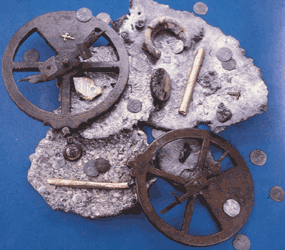
NPS photo But the story of the 1554 shipwreck does not end there nor does it end with the conclusion of the salvage operations that took place later that year. As with any important historical event, its effects resonate through the centuries and can still be felt today—if one looks for them. First of all, the wrecks were the first documented occurrence of Europeans on the island and one of the first occurrences of Europeans in what was to become Texas. The salvage operation was the first documented instance of Europeans intentionally coming to the island and staying for an extended period. Second, the three ships that wrecked (the Santa Maria de Yciar, the Espiritu Santo, and the San Esteban) are the oldest shipwrecks ever found in North America (excluding the Caribbean and Latin America). Third, when the remains of the ships were discovered in 1967, a private company called Platoro, Ltd. began excavating them. This set off a long, legal battle over ownership of the remains as Texas had no laws governing antiquities at the time. In the long run, the state won its case and the remains were turned over to the National Park Service, who has transferred curation of the artifacts to the Corpus Christi Museum of Science and History, where they may now be viewed. Historian and Marine Archeologist Dr. Donald Keith, President of the Ships of Discovery at the Corpus Christi Museum of Science and History, notes that: “The 1554 shipwrecks are important for a lot of reasons. The "mining" of them by Platoro caused the State of Texas to realize that shipwrecks and archaeological sites in general are important, and the property of the people and the state. They are cultural resources that have to be cared for. Some of the earliest experiments in the conservation of artifacts from the sea were done on the objects and hull remains that were recovered from the sites that Platoro and the State worked…The Platoro conflict did lead to the establishment of the Texas Antiquities Committee, which led to the Texas Historical Commission, which led to the discovery and excavation of La Belle [the ship of the French explorer La Salle, found on the Texas coast within the past few years] among other accomplishments.” This third and last effect on our present society is undoubtedly the most important, because it resulted in new Texas laws to protect archeological resources. These laws follow the federal Antiquities Act in spirit, which gives federal agencies custody of relics found within their jurisdictions so that they may be properly protected and studied. Thus, instead of ending up in private collections where they become curiosities for a fortunate few, the knowledge derived from the artifacts goes to the public in the form of publications and exhibits in museums and on websites. Bits and pieces of the 1554 wrecks and many other historical events still wash up on the island or can be found emerging from the sands. If you discover something, please remember that the right thing to do is leave it where it is and report it to us, so that we may conduct a proper archeological dig and learn more about the rich history of the island and share our findings (and yours) with the world. |
Last updated: February 18, 2025
